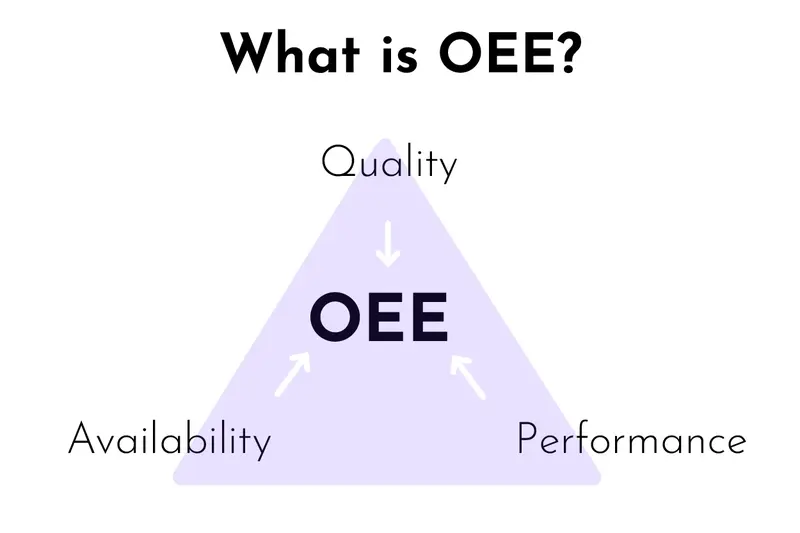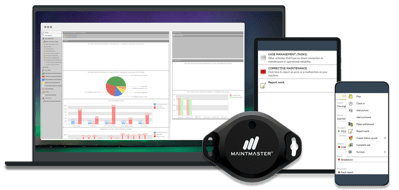Why OEE matters in modern manufacturing
Manufacturing efficiency is the foundation of a company’s profitability and competitiveness. Production managers and executives face constant challenges in reducing downtime, increasing throughput, and ensuring product quality—all while controlling costs and optimising resource utilisation. However, without the right tools and metrics, understanding where inefficiencies lie can be difficult.
This is where Overall Equipment Effectiveness (OEE) comes in. OEE is one of the most effective and widely used Key Performance Indicators (KPIs) in the manufacturing industry. It provides a clear, measurable way to assess how well production equipment is being used and highlights where losses occur.
By mastering the OEE game manufacturers can:
- Identify bottlenecks in their production lines.
- Reduce unplanned downtime and improve machine availability.
- Optimise cycle times and eliminate inefficiencies.
- Improve product quality and minimise defects.
- Increase overall profitability by enhancing productivity.
This guide will cover:
- What OEE is and why it’s crucial for manufacturers.
- How to calculate OEE with a breakdown of its three components.
- Industry benchmarks and standards for OEE.
- Real-world use cases of OEE improvements.
- Why MaintMaster OEE is a superior choice compared to MES and ERP solutions.
By the end, you’ll have a clear understanding of how OEE can drive continuous improvement and why investing in the right OEE software is a game-changer.
What is OEE?
A Key Performance Metric for manufacturing efficiency

Overall Equipment Effectiveness (OEE) is a standardised metric used in manufacturing to measure how effectively production equipment is used. Developed as part of Total Productive Maintenance (TPM) in Japan, OEE provides a structured method for identifying production inefficiencies and opportunities for improvement.
At its core, OEE evaluates three critical factors:
- Availability – Measures how often equipment is operational when it’s supposed to be.
- Performance – Assesses how efficiently equipment runs compared to its optimal speed.
- Quality – Evaluates the proportion of defect-free products in production.
These three factors are multiplied to determine an overall OEE score, offering a clear and quantifiable measure of equipment efficiency.
A perfect OEE score of 100% would mean that production operations experience:
- No downtime (100% Availability)
- Full-speed operation (100% Performance)
- Zero defects (100% Quality)
However, in real-world manufacturing environments, achieving 100% OEE is nearly impossible due to:
- Planned maintenance and scheduled downtime.
- Machine wear and operational slowdowns.
- Quality fluctuations due to raw material variations.
- Human errors and process deviations.
Instead of striving for an unrealistic 100%, manufacturers should focus on continuous improvement by addressing specific inefficiencies in their OEE components.
How to calculate OEE
The standard formula for calculating OEE is:
OEE = Availability × Performance × Quality

Each component must be calculated separately:
-
Availability (%) – Measuring uptime
Availability measures the percentage of planned production time that equipment is actually operational.

Causes of availability loss:
- Unplanned downtime – Equipment breakdowns, power failures, emergency maintenance.
- Planned downtime – Changeovers, scheduled maintenance, material shortages.
- Setup and adjustments – Excessive calibration or tooling changes.
-
Performance (%) – Measuring speed efficiency
Performance evaluates how efficiently equipment runs relative to its optimal speed.

Causes of performance loss:
- Running below optimal speed – Operators reducing speed to avoid quality defects.
- Short stops – Small but frequent interruptions such as sensor errors or brief jams.
- Machine inefficiencies – Suboptimal tool settings, lubrication issues, energy inefficiencies.
-
Quality (%) – Measuring product yield
Quality calculates the percentage of defect-free products.

Causes of quality loss:
- Defective parts – Manufacturing errors, raw material inconsistencies.
- Rework and scrap – Products that require modifications or must be discarded.
- Operator variability – Human errors in machine operation or manual assembly.
By multiplying these three factors, manufacturers gain a clear picture of how much production capacity is being lost and where improvements are needed.
Industry Standards for OEE
Instead of chasing an 85% benchmark, manufacturers should:
- Focus on gradual, data-driven improvements.
- Identify and resolve specific inefficiencies in Availability, Performance, or Quality.
- Leverage OEE software to track and analyse trends over time.

Real-World applications of OEE
OEE is not just a theoretical concept—it has been successfully implemented across various industries to identify inefficiencies, reduce waste, and enhance productivity. Below are three real-world cases demonstrating how manufacturers improved their OEE and achieved significant operational benefits.
Reducing downtime and increasing output in the Food & Beverage industry
A leading food and beverage manufacturer was struggling with inefficiencies across its production lines, with frequent unplanned downtime, slow changeovers, and inconsistent throughput. Their OEE score was hovering around 52%, with major inefficiencies in availability and performance. Upon closer analysis, it was discovered that changeovers between different product variations were taking significantly longer than expected, leading to idle machines and lost production time. Additionally, unexpected stoppages due to equipment failures and supply chain delays were severely impacting overall efficiency.
To tackle these issues, the company implemented a real-time OEE monitoring system to track downtime causes more accurately and introduced a predictive maintenance strategy to prevent unexpected equipment failures. Furthermore, they optimised their production scheduling and trained operators to perform changeovers more efficiently. The impact of these changes was profound—within six months, their OEE increased from 52% to 67%, changeover times were cut by 40%, and unplanned downtime was reduced by 30%. By leveraging OEE insights, they were able to increase their production output without additional equipment investment, improving profitability while maintaining product quality.
Enhancing speed and quality in the Industrial Equipment sector
A manufacturer of industrial machinery faced significant inefficiencies in both Performance and Quality, resulting in an OEE score of just 48%. Their machines were running at only 75% of the optimal speed, and scrap rates were alarmingly high, leading to material waste and lost production time. The company also relied on manual data collection for OEE tracking, which led to inaccurate reporting and delays in identifying problem areas.
In an effort to improve efficiency, the company replaced manual OEE tracking with an automated OEE system, allowing them to collect accurate, real-time production data. This helped them pinpoint speed inefficiencies and cycle-time variations, leading to targeted process improvements. Simultaneously, they introduced operator training programs to ensure machines were running at their optimal speeds. To address high defect rates, the company implemented quality control checkpoints throughout the production process, enabling early detection and correction of defects before they reached the final stage.
The results were impressive—Performance efficiency increased by 18%, scrap rates were reduced by 35%, and OEE improved from 48% to 71% within nine months. By focusing on real-time data analysis and process optimisation, the company was able to improve efficiency, reduce costs, and enhance product quality.
Optimising production without expansion – CooperVision’s success with OEE
CooperVision, one of the world’s leading manufacturers of contact lenses, faced a major challenge: growing market demand without the ability to expand production facilities. With no space to install new lines, they needed a way to increase output using existing resources. An analysis of OEE metrics revealed that inefficiencies—rather than capacity limits—were the real issue.
The key problems identified were inconsistent batch changeover times, lack of real-time visibility into production losses, and unplanned downtime. Instead of investing in new infrastructure, CooperVision focused on improving efficiency. They introduced automated performance tracking, optimised changeover processes, and implemented proactive maintenance strategies to reduce variability.
Within two years, these improvements led to a 20% increase in OEE, a significant reduction in downtime, and better standardisation of production processes. Most impressively, the investment paid off in just 14 days, proving that enhancing operational efficiency can be just as impactful as adding new production lines—without the cost or space requirements.
Key takeaways from these OEE Use Cases
These real-world examples demonstrate how OEE optimisation can drive measurable improvements in manufacturing efficiency, reduce costs, and enhance overall productivity. The key lessons learned from these cases include:
- Real-time data collection improves decision-making – Automating OEE tracking eliminates errors from manual data entry, enabling manufacturers to make data-driven decisions faster and more accurately.
- Predictive maintenance reduces downtime – Identifying and addressing equipment issues before they cause breakdowns significantly improves Availability and reduces unexpected stoppages.
- Optimising changeover times boosts efficiency – Standardising and refining changeover processes leads to shorter machine idle times and higher production throughput without requiring additional resources.
- Targeted process improvements enhance speed and quality – Addressing Performance inefficiencies and implementing quality control checkpoints helps maintain product standards while minimising waste and rework.
- Maximising existing resources can be more effective than expansion – As seen in the CooperVision case, increasing OEE allows manufacturers to boost output without investing in new equipment or facilities, proving that operational efficiency can be a smarter and more cost-effective solution than expansion.
- Employee engagement plays a crucial role in sustaining OEE improvements – Providing visibility into performance metrics and involving operators in process improvements fosters a culture of continuous improvement and accountability.
By focusing on Availability, Performance, and Quality, manufacturers can unlock hidden efficiencies, reduce costs, and drive long-term operational excellence. These use cases prove that OEE is not just a measurement tool—it is a strategic driver of continuous improvement and business success.
Why MaintMaster OEE stands out from other OEE and MES solutions
Many manufacturers rely on basic OEE tracking features within ERP and MES software. While these solutions offer some level of reporting, they often fail to provide the depth, automation, and real-time insights needed to drive true performance improvements.
Why MaintMaster OEE outperforms traditional MES Software
- Automated data collection – Eliminates errors and inefficiencies from manual data entry.
- Live dashboards & predictive analytics – Provides real-time tracking and alerts to prevent performance losses before they happen.
- Advanced root cause analysis – Goes beyond basic OEE tracking by diagnosing specific issues affecting Availability, Performance, and Quality.
- Customisable reports & comparisons – Tracks OEE trends across different machines, shifts, and locations.
- Seamless integration – Works alongside CMMS, MES, SCADA, and ERP systems without replacing them.
Unlike MES solutions, which often provide only surface-level OEE insights, MaintMaster OEE is built specifically to drive continuous improvement.
Final thoughts & next steps
OEE is not just a performance measurement tool—it’s a strategic driver for operational excellence. Understanding and optimising OEE can help manufacturers:
- Reduce downtime and improve machine availability.
- Enhance production speed without sacrificing quality.
- Identify hidden inefficiencies and reduce operational costs.
If you’re looking to move beyond basic OEE tracking and leverage real-time, data-driven insights, investing in advanced OEE software like MaintMaster OEE is the next logical step.



